
3M Advocates Talent Reform, Automation to Boost Mexico’s Industry
Mexico’s competitiveness in advanced manufacturing faces significant challenges unless systemic changes are made to develop and integrate technical talent. This was the central theme at Diálogos de Impacto: Impulsando el Futuro de la Manufactura, a forum organized by 3M in San Luis Potosi that convened government, academia, and industry leaders.
Held at the San Luis Potosi Convention Center, the event highlighted the widening gap between the rapid transformation of manufacturing and Mexico’s lagging educational and training systems. Discussions centered on findings from 3M’s report, Talent Gap in Manufacturing: Today’s Challenge for Tomorrow’s Competitiveness, which outlines key obstacles and opportunities for the workforce amid technological disruption.
“Educational models are not keeping pace with industry demands,” said María Fernanda Guarro, Managing Director, 3M Mexico.
According to the report, Mexico boasts a favorable demographic profile, a growing STEM-educated workforce, and a strong industrial base. However, a lack of coordinated national strategies risks squandering these advantages.
“Mexico’s demographic bonus is nearing its end. Without action, the working-age population will shrink, leaving the dependent population to outnumber the labor force. The peak of this bonus was in 2010,” said María Teresa Galicia, Director of Labor Inclusion, Ministry of Labor and Social Welfare (STPS).
Galicia shared regional labor data, noting that in San Luis Potosi, 77 out of every 100 men aged 18–54 are employed, compared to just 55 out of every 100 women in the same age group.

Preparing for the Future of Manufacturing
The report underscores the urgent need for a workforce proficient in automation, AI, and robotics. By 2030, critical skills will include AI, big data, cybersecurity, and digital literacy, according to the World Economic Forum’s Future of Jobs Report 2025.
3M proposes a national strategy based on four pillars:
-
Expanding technical education in disciplines like electromechanics, automation, and data systems.
-
Promoting inclusivity for women and underrepresented groups in STEM fields.
-
Strengthening public-private-academic partnerships to align training with labor market needs.
-
Fostering early STEM engagement among young students.
“As part of its social responsibility efforts, 3M introduces science to children from early childhood,” said Guarro, emphasizing the importance of sparking interest in technology at a young age.
The Promise of Dual Education Models
Dual education, which integrates classroom learning with workplace experience, was a core topic.
“Dual education is the most effective way for students to enter the labor market. The German model, which emphasizes collaboration between companies and educational institutions, has proven highly successful,” said Gylmar Mariel Cárdenas, Secretary of University Engagement at Universidad Autónoma de San Luis Potosi (UASLP).
UASLP has implemented innovative dual education initiatives, including:
-
Permanent company offices on campus for seamless academic and corporate collaboration.
-
Short-term student projects within companies.
-
Regular expert talks and site visits to industry facilities.
Addressing Perceptions and Challenges
Despite strong public perception of manufacturing careers—80% of Mexican adults recommend them—concerns persist. According to 3M, 31% of respondents cite job instability, 27% point to low wages, and 81% fear automation will eliminate jobs.
“Building trust in automation as a driver of productivity, not a threat to employment, is essential,” the report notes.
At the same time, 84% of adults believe manufacturing jobs now require higher skills due to emerging technologies. This shift offers an opportunity to redefine technical careers as desirable, resilient, and impactful in the digital economy.
3M’s Strategy: Automation With Purpose
As part of its commitment to innovation, 3M is pursuing an ambitious automation plan at its San Luis Potosí facilities, particularly its adhesive tape manufacturing plant. By 2026, the company aims to automate 50–70% of its operations.
However, 3M clarified that automation aims to enhance efficiency and improve working conditions, not replace workers. “The goal is to make tasks more efficient and less physically demanding, not to eliminate jobs,” company representatives affirmed during the forum.

